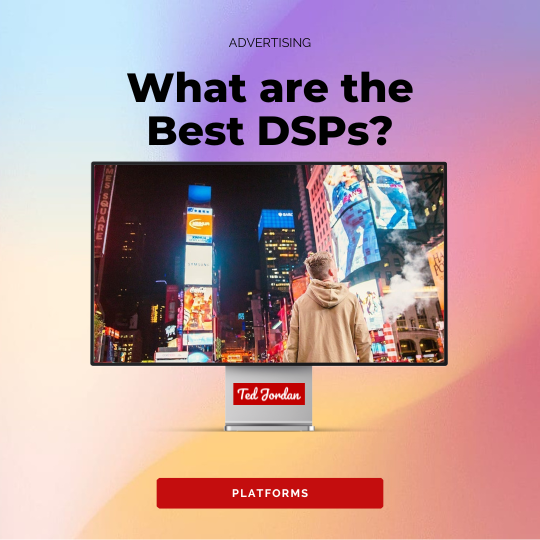Advertisers often ask Ted Jordan: what are the best DSPs in Programmatic and how to choose one? Using a good Demand-Side Platform is key to succeed and reach potential converters in advertising. With a large number of managed and self-served DSPs in the Programmatic ecosystem, it may be difficult to pick a platform. How to choose the right one for you?
Used by small and medium businesses and marketing agencies like ours, DSPs give advertisers access to domains and ad spaces they could not deliver on otherwise. Depending on the ad format, it is sometimes harder to track post-click conversions, but analytics and insight tools, available on Demand-Side Platforms, are usually good enough to track the data you need for optimising your campaigns.
Help me choose a good DSP
To pick a good DSP, you have to take numerous factors into account: planning tools, bidding rules, ad inventory, AdTech stack, platform fees, budget thresholds, etc.
Our Programmatic Expert, Ted Jordan, uses several DSPs to manage his clients’ Programmatic campaigns on a daily basis. To save you time and headaches, he combined for you a list of important factors to consider when choosing a Demand-Side Platform. This way, you’ll have all the necessary information to pick the best DSP for your 2025 Programmatic campaigns.

Before choosing the top DSP for your Programmatic campaigns, take these factors into account:
- Cross-platform/cross-device possibilities.
- Access and granularity of planning tools.
- Data privacy and compliance.
- Type of DSP: self-serve or managed.
- Integration and compatibility with other platforms and APIs.
- Support system (chat, mails, tickets, estimated time to receive an answer).
- Ad formats and ad inventory.
- UX (user experience).
- Tracking features (conversion attribution, post-view, post-click, etc.)
- Transparency and cost of platform fees.
- Analytics tools (filtering options, formats, etc.).
- Traffic health/ad fraud/brand safety measures (Double Verify, IAS…).
- Targeting options.
- Bidding rules (CPC, CPM, CPA).
- Access to demo campaigns to test the DSP features.
- Day parting and scheduling options to deliver when it’s the most profitable.
Considering all these decisive points, here is Ted Jordan’s list of top DSPs in 2025.
Top DSPs in 2025 – Our pick
There are 10 DSPs in our top list this year:
Our list of DSPs includes major DSPs, popular ones, and some DSPs worth being discovered, such as Displayce if you advertise in France. Ted Jordan is also the only Yahoo DSP access provider in France and in Belgium and offers great advantages, such as profit margin, custom deals and no ad serving fees.
Each of these Demand-Side Platforms has pros and cons and specificities. We made sure to give you as much information as possible about these Programmatic platforms so you’ll have a clear idea of which DSP is best for you after reading this article.
Best DSPs for Display and Native campaigns: Outbrain DSP, Yahoo DSP.
Top DSPs for DOOH campaigns: HAWK DSP, Displayce, Yahoo DSP.
Best eco-friendly DSP: Adform.
Best omnichannel DSP: HAWK DSP.
Best DSPs for video ads (video, CTV, TV, VOL): Microsoft Invest, HAWK DSP, Yahoo DSP, The Trade Desk, Adform.
Top DSPs for in-app campaigns: Outbrain DSP, HAWK DSP.
Top user-friendly DSPs: The Trade Desk, StackAdapt.
Best O&O DSPs: DV360, Yahoo DSP, Amazon Advertising.
Yahoo DSP
Yahoo DSP is an omnichannel advertising platform where you can deliver the most popular Programmatic ad formats: Connected TV, DOOH, Native, Display, etc. Unique tracking solutions, precise custom audiences, an amazing free audience insight tool: the platform is user-friendly and the support hub is brilliant!
Yahoo DSP’s strength is definitely its O&O inventory and its premium one, thanks to Yahoo Backstage. The Yahoo data is also one of the best on the market: 625M Yahoo user profiles and 200+ partners.
Yahoo DSP pros
- No ad serving fees.
- Premium CTV providers such as Paramount.
- AI-powered optimisation in real time with Yahoo Blueprint.
- Large Premium and O&O inventory.
- Custom audiences created on Yahoo DSP can be reused on Taboola.
- Free audience insights.
- No hidden fees.
- Multi-KPI optimisation features.
Yahoo DSP cons
- Post-click conversion attribution is not always working when using pixels (use S2S or Yahoo CAPI instead).
- Optimisation features can be overwhelming at first.

Note that Ted Jordan is the only access provider for Yahoo DSP in France and in Belgium. If you’re interested in running ads through this Demand-Side Platform, contact our team now.
Outbrain DSP
Outbrain DSP (formerly known as Zemanta) is definitely the best DSP, alongside Yahoo DSP, when using Display and Native ad formats. This multichannel Demand-Side Platform is specialised in post-click behaviour optimisation, which makes it a great advertiser’s ally.
Outbrain’s self-serve DSP offers great features, such as automatic campaign optimisation, Google Analytics (GA) and Adobe Analytics integration (server-to-server also called S2S) and competitive CPCs. Outbrain DSP also offers content recommendations based on your content and performances: this is the best DSP for performance Native and Display campaigns, followed by StackAdapt and Microsoft Invest.
Outbrain DSP pros
- Competitive CPCs, CPMs and audience fees.
- Analytics tools integration.
- Ad format, subdomain and domain optimisation options.
- Great planner tool granularity for benchmarks.
- Automatic campaign optimisation.
- Content suggestions based on content and performances.
- Customer service is available through various channels: mails, live chats.
- Plenty of resources available to learn from.
Outbrain DSP cons
- Only focus on Display, Native and Video ad formats.
- Deals can be time-consuming to set up with the use of specific SSPs.
- Post-click conversion attribution is often glitchy (since September 2024).
- Platform fee calculation based on advertisers’ spending.
- Inventories are not always available or updated for in-app campaigns.
- Price range on the high side, so it might not be the best for small businesses.

HAWK DSP
The top DSP for Programmatic Advertising across multiple channels, especially DOOH, is HAWK DSP by Azerion. This European cookieless centric platform gives you all the tools you need to deliver across all formats and devices: DOOH, CTV, Audio, Video, etc. For example, its planning tool for DOOH and Audio ads is so precise you’ll never get any bad surprises when delivering on a specific screen.
Also, when combined with an ad server and proper set-up, delivery is never an issue. With HAWK DSP, you always reach 100% of delivery at the end of your campaigns!
Access our Free Course now – No credit card needed
Thanks to device ID attribution, post-click conversions for drive-to-store campaigns (DTS) are collected and tracked accurately. Advertisers can track how many customers went to a store and bought a product after hearing or seeing an ad, for example.
Also, HAWK DSP’s reporting tools are available on a specific interface, which speeds reporting up. You can track all your KPIs and campaign performances in one place.
We could not mention HAWK without talking about Azerion. Like many other AdTech platforms, Azerion owns HAWK DSP. This advertising giant is on the verge of becoming the number one AdTech stack in Europe: Audio SSP (Targetspot), Display takeover platform (Sublime), omnichannel DSP (HAWK DSP), audience mapping tool based on cookieless data (Captify tool), etc. The list goes on…
HAWK DSP pros
- Multichannel DSP with a cookieless format focus.
- Great O&O inventory thanks to Azerion stack.
- Optimised insights and analytics tools on a separate interface.
- Fixed CPM bidding system for in-app campaigns for better budget and delivery control.
- Possibility to bid on screen IDs for pDOOH campaigns.
- DOOH and Audio planner granularity and precision.
- Drive to store tracking performances thanks to Mobile ID.
HAWK DSP cons
- Cookie tracking is still under development.
- Bid multipliers are not available at inventory level.
- Display bidding rules are not optimised.

Ted Jordan also recommends Displayce DSP for your DOOH campaigns. This French pDOOH platform allows advertisers to run campaigns across 70 countries and offers a network of 1M+ billboards. Displayce has a great direct booking system where you could save on CPM spend for your campaigns.
They partner with premium SSPs such as Broadsign, a leader in DOOH advertising in France.

Adform DSP
DSPs and SSPs generate massive carbon emissions. Just in the US, for example, “58.8 grams of CO2 emissions are wasted on fraud for every 1,000 impressions” (source: Scope3).
To reduce the industry’s carbon footprint, Adform uses a “carbon reduction feature” powered by Scope3, a platform checking the carbon emissions of advertising and tech platforms. You can optimise your campaigns based on carbon footprint: isn’t it exceptional? This makes Adform DSP the best eco-friendly DSP in Programmatic Advertising so far.
This Danish Demand-Side Platform is also great for data privacy compliance and is considered one of the main competitors of The Trade Desk (TTD). The top 3 countries to deliver with Adform, with 100% viewable traffic, are Denmark, Spain and the US.
With Adform, you can activate the full potential of media buying. This AdTech stack offers media and advertising agencies an ad server, a DSP, a DMP, carbon reduction and omnichannel activation. For example, Ted Jordan often uses Adform’s ad server to reduce advertising costs while delivering top-notch Programmatic campaigns for his clients.
Some of the key features of Adform DSP are the automatic bidding improving system and automatic campaign optimisation technologies. Some advanced bidding strategies are used, such as CPA.
Adform DSP pros
- Strong ad server and a variety of ad formats.
- Eco-friendly AdTech stack with carbon footprint optimisation.
- Adform academy: courses and certifications.
- Strong CTV, VOL and DOOH traffic in European cities.
- Detailed Analytics.
- 100% viewable traffic.
- Automatic bidding improving system and campaign optimisation.
- Great data privacy compliance and brand safety measures.
Adform DSP cons
- Reach may be limited outside Europe and the US.
- It takes some time to understand how to use this DSP despite getting access to the Adform academy.
- Hidden reporting costs, which are not ideal for tight advertising budgets.

Microsoft Invest (Microsoft Advertising)
Our top pick for reach, seat accessibility and video ads is Microsoft Invest (formerly Xandr), the video-focused Demand-Side Platform managed by Microsoft. This DSP offers premium CTV inventory and great video ad placements: Microsoft Invest’s inventory covers up to 90% of Smart TV households thanks to huge streaming platforms like Netflix.
This premium DSP is also easily accessible, which means small businesses can create a seat too! Know that access to good DSPs is often denied to small businesses, or the minimum spend requested by these platforms is usually too high (The Trade Desk, for example).
Microsoft Invest gives advertisers access to reputable worldwide publishers. The use of first-party data, thanks to Microsoft Advertising, provides great data relevance. Additionally, cross-device and platform-targeting are on point… and so is their IP and cross-device conversion matching system. This massive advertising company created Universal Event Tracking.
Microsoft DSP pros
- Seat accessibility.
- Netflix DSP access and large video inventory.
- Universal Event Tracking: pixel system tracking conversion across devices and IP addresses.
- Microsoft’s data and publishers.
- Integration with several Supply-Side Platforms.
- Robust analytics tools.
Microsoft DSP cons
- Slow creative approval.
- High CPCs for Display.
- No access to Hivestack via Microsoft Invest.
- Long waiting time when reaching the support team (ticketing system).

The Trade Desk
The Trade Desk (TTD) is the easiest DSP to use (alongside StackAdapt) and one of the best platforms for CTV ads. Experts and new users are able to buy ad spaces easily once they access the platform. Unfortunately, it is hard to get an account on this self-serve DSP because it’s one of the most popular DSPs on the market; The Trade Desk is considered as a major Demand-Side Platform. This advertising platform requests agencies to spend a minimum budget each month, which may be frustrating.
The main selling point of TTD is its strong network: The Trade Desk works with 400+ partners (Hulu, Disney, FOX, Spotify, ESPN, Netflix*, etc.). This premium inventory adds even more advantages to this Demand-Side Platform, alongside the possibility of integrating analytics platforms to track your campaign data.
Another great feature is audience pricing. If you select audiences created from the same cookies, from different data providers on TTD, you’ll pay the cheapest fee for these audiences.
The Trade Desk pros
- Great and available support team.
- Platform and creative uploads are user-friendly.
- One of the best platforms for CTV advertising.
- Easy to use.
- Good algorithm.
- Important audio inventory.
- Strong network with 400+ partners.
The Trade Desk cons
- Hard to get an account.
- Targeting by subdomains is not possible.
- Reporting tool filtering is lacking (not possible to filter demographic data, for example).
- Planning tools are almost inexistent.
- High platform fees and mandatory minimum spend per month.

*Netflix inventory is also available on Microsoft Advertising (Microsoft Invest), DV360 and Magnite.
StackAdapt
StackAdapt is an AI-powered DSP used by more and more marketing agencies and advertisers. This multichannel DSP is perfect for running Native and Display ads, in-game campaigns, CTV ads and DOOH.
StackAdapt is really easy to use and its customer service is top-notch, which makes it perfect for beginners. Brand safety, contextual targeting and Account-Base Marketing targeting (ABM) for B2B clients are among the various reasons Ted Jordan decided to include this DSP in the top DSPs of 2025.
Unfortunately, reporting is often difficult or glitchy on StackAdapt. The main disadvantage of using this DSP if you have a tight budget is the platform fees: it’s unclear how much you’ll pay to use the platform until you receive your invoice.
Nonetheless, brand safety measures and AI-powered targeting and retargeting options help advertisers reach their customers more efficiently. In Programmatic advertising, this is crucial.
StackAdapt Pros
- Great customer service.
- User-friendly DSP.
- Multichannel approach with premium DOOH inventory (Disney+).
- No minimum spend.
- Brand safety measures.
- Great targeting features powered by AI.
StackAdapt Cons
- Non-transparent platform fees.
- Reporting issues.

DV360 and Amazon Advertising
There is a tie between Google Display & Video 360 (DV360) and Amazon Advertising for the best O&O DSP title alongside Yahoo DSP. If you don’t know, O&O means Owned and Operated content in Advertising.
Data is the distinguishable element for these two DSPs: Amazon and Google inventories. On DV360, you can access the Google ecosystem such as YouTube. While on Amazon Advertising, Twitch and Prime’s ad spaces are available to use. But great news for DV360 users: Netflix’s inventory is accessible through DV360 since last year!
Accurate targeting based on browsing habits, past purchases and search queries allows advertisers to drive sales more easily than on other Demand-Side Platforms. Unfortunately, that’s all the pros for DV360 and Amazon Advertising.
Pros
- O&O Inventory.
- Netflix ad spaces for DV360.
- Data’s accuracy.
Cons
- Algorithm.
- High minimum spend and high fees.
- Limited reach outside of their O&O inventory.


Which DSP will you choose?
Remember, in order to pick the best DSP you need to take into account important features and information such as your budget, your goals and the DSPs features. You now also know what the advantages and disadvantages of each DSP are.
You can, of course, use one or more Demand-Side Platforms to advertise. But in order to save time and money, consider all the information we have shared with you.
Now that you know how to choose a good DSP, based on your budget and needs, which one will you choose?
If you need help with picking or using a Demand-Side Platform for your Programmatic campaigns, reach out to Ted Jordan. This Programmatic Expert will be able to help you.
Feel free to check these other articles: what is an ad server, what are SSPs, omnichannel vs multichannel marketing, native vs display ads, etc.



